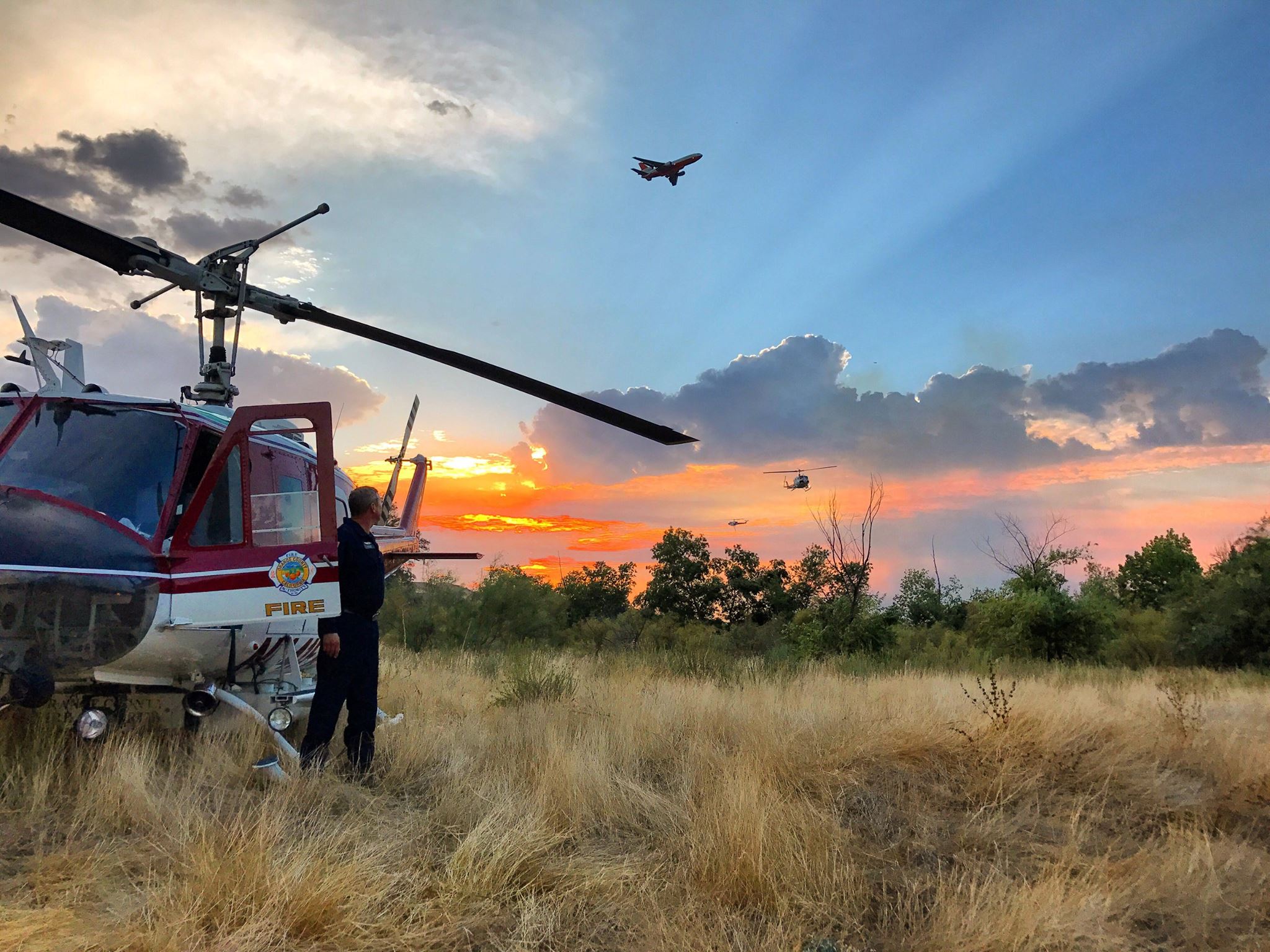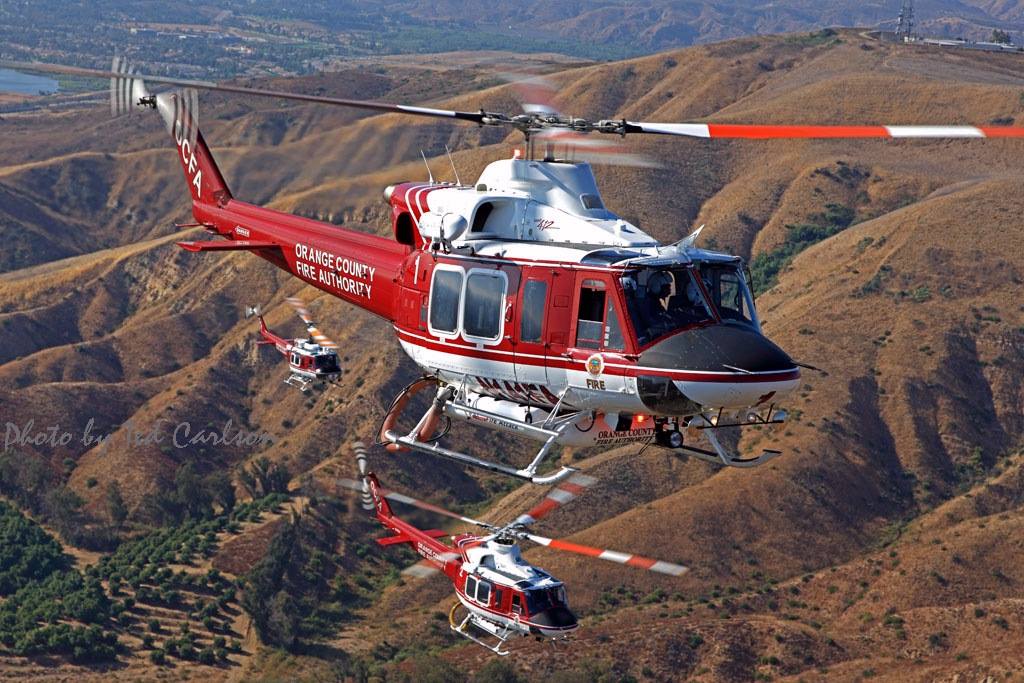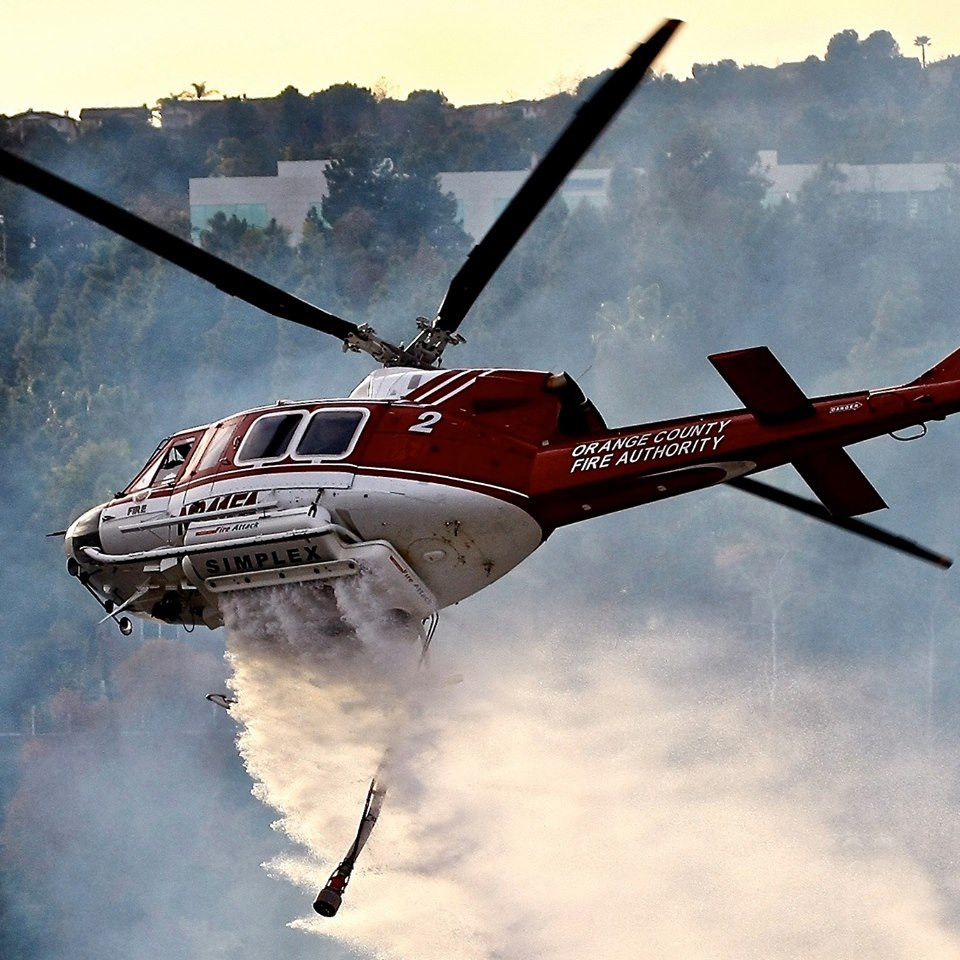Long before the fire season of 1993, dedicated members of the Orange County Fire Department were proposing plans to acquire and operate our own firefighting helicopters. Legend has it that in 1978 the “Orange Ranger Unit” was scheduled to get a helicopter. So sure were we that we quickly formed a Helitack Crew. Although the helicopter never materialized, the crew found an alternate mode of transportation to the fire that led to their informal re-designation as the “Bus Attack Crew.” Some of those Bus Attack crew members are still around, but few will admit it.
That setback did not discourage us. With the transition from CDF to the Orange County Fire Department, members of the organization continued to recognize the need for our own firefighting helicopters. During the late 1980’s adn early 1990’s, John Howlind, Bob Pracht, Paul Keim and Tom Evans collaborated to prepare a comprehensive proposal in initiate a Firefighting Helicopter Program. Calling on their experience as National Guard Pilots, Bob, Paul, Kevin, and Tom were instrumental in laying out the possibilities and educating the various members of the organization on the basics of a helicopter program.
October of 1993 brought with it the most devastating fire season that Orange County had ever experienced. Over 36,000 acres burned and 469 homes destroyed or severely damaged. After-action reports published that year emphasized the fact that the OCFD did not have firefighting helicopters, and the OCFD’s Laguna incident command staff believed immediate air support could have made the Laguna Fire manageable during the firest quarter hour of its spread. Reports like these helped the Orange County Board of Supervisors to approve the OCFD to enter into a one year contract for a firefighting helicopter with pilots, mechanics, a fuel truck and a fuel truck driver. This wasn’t exactly like buying a new helicopter, building a hanger, and sending a bunch of our folks to Bell Helicopter School, but that’s how it all started.

Our first contract for helicopter service with Evergreen Helicopters Inc. of McMinville Oregon included providing qualified pilots, maintenance technicians and a 900 gallon fuel truck with a driver. It was with that arrangement that we responded to our first incident on June 22, 1994. That year was also a first for many other types of calls ranging from wildland fires, medical rescues, and responses to weather related emergencies. We setup shop in a hanger on the west side of John Wayne Airport, and because the closest fire station was Station 33, it was decided that we would be called ORCO Copter 33.
Years earlier we had acquired three helicopters through the Federal Excess Property Program (FEPP). That is a program that allows the Federal Government to reassign aircraft it no longer deems serviceable to other government agencies. These are helicopters that were used by the Army in the 1960s, subsequently given to the National Guard at the end of the Vietnam conflict, and eventually declared to be surplus equipment by the Department of Defense. Those “surplus” aircraft were transferred from the Department of Defense (DoD) to the Department of Agriculture (DoA) to the United States Forest Service (USFA) to the California Department of Forestry (CDF) to the Orange County Fire Department (OCFD). So we don’t exactly own them, but they are permanently assigned to us. In 1994, while we were contracting for helicopter service from Evergreen, we were contracting with San Joaquin Helicopters in Delano California to refurbish two of the three FEPP helicopters and to turn them into “Super Hueys.” We hoped to have at least one of those aircraft ready by the end of the one-year contract with Evergreen. However, we were unable to get either of the extensive modifications completed in time. So, we decided to take the last remaining FEPP airframe and make it flyable as an unmodified UH-1H Huey helicopter with a Bambi Bucket and a minimal complement of radios.

When the Evergreen contract ended in 1995, we were ready to put our own first helicopter in service. It was an unmodified UH-1H helicopter designated Copter 341 and was intended to fill the gap as a water dropping aircraft while two other UH-1H airframes were undergoing refurbishment and modifications. During that time, we moved out of our leased hangar with its tiny windowless office at John Wayne Airport and into Hangar at Fullerton Airport. The 10,000 square foot hangar had sat empty for several years in a remote weed infested corner of the airfield. We took it on an “as-is” lease and quickly made it our own. We hired helicopter maintenance personnel and outfitted it into a well-functioning maintenance and repair facility. We could squeeze all three helicopters into the hangar bays and had just enough office space to provide a desk and chair for pilots, crew chiefs, and a Battalion Chief. The Copter 33 designation was no longer appropriate and we needed a new name, or at least a new number. Unfortunately, all of the really good numbers were already taken. So after much thought and consideration, it was decided that we would inherit the number 41 from the former Station 41 in Holy Jim Canyon.
By the start of the 1996 fire season we had become the Orange County Fire Authority and we were operating the first of our newly completed UH-1 “Super Huey” helicopters. That helicopter came to be known as Copter 41. Refurbishment of the second Super Huey, designated Copter 241 was completed in 1997. At that point, we had a fleet of three helicopters; Copter 41, 241 and 341. We also had two fuel tenders that were acquired through the FEPP. They were designated Helitender 41 and Helitender 241. All of those radio designator seemed like a good idea at the time. But within a few years, the 241 Toll Road was completed and connected the 91 Freeway to new communities in south Orange County by transecting miles of open wildland along the foothills of the Cleveland National Forest. Soon we were responding to vegetation fires along the Toll Road that the ICs aptly named, the 241 Fire. You can probably imagine the tongue twisting confusion that transpired.

In 1999 we purchase our first rescue hoist and embarked on a mission to develop an all-risk helicopter rescue capability. By 2005 we had approval to purchase the latest generation of night vision goggles and were quickly learning how to use them to safely perform all of our flight missions in the darkness of night. This was a huge technological leap that put the OCFA on the cutting edge of aerial firefighting. We thought we had it all. But then, in 2008, the OCFA decided to supplement its fleet of aging helicopters with two brand new Bell 412ep twin-engine helicopters. We took delivery of the first new aircraft at the Helicopter Association International Expo at the Anaheim Convention Center. We took the opportunity to change the radio identifiers on the new helicopters and branded them as Copter 1 and Copter 2. We soon gave the two remaining Super Hueys new paint jobs and re-designated them as Copters 3 and 4. Again, we were on the cutting edge. How could it get any better? Here’s how. In 2012 we moved our operation across the runway at Fullerton Airport into a newly completed 22,000 square foot hangar building! Three huge hangar bays with an overhead crane, plenty of office space, a training room, showers, a kitchen, and a day room with floor to ceiling windows overlooking the flight line.
In 2010, an independent audit was completed on the program, the Speas Report. This report recommended further enhancements to the program, namely operational periods and constant staffing. Unfortunately, before we could enact the recommendations, an economic downturn delayed our progress. In 2015, with an improved economic outlook, the OCFA Board of Directors authorized the Fire Chief to enhance the programs operations by providing 24 hour a day staffing. Further following the Speas Report recommendations, a dedicated helicopter paramedic rescuer was added in 2016 to improve our all hazard all-risk 24/7 operational capability.
We have faced challenges and overcome obstacles, but we never stopped learning or stopped trying to increase the value of our service to the public and the members of the OCFA. We had a vision that took us from a single helicopter that only dropped water on wildland fires during daylight hours to be an all-risk helicopter program that operates a fleet of modern aircraft to provide protection from above.